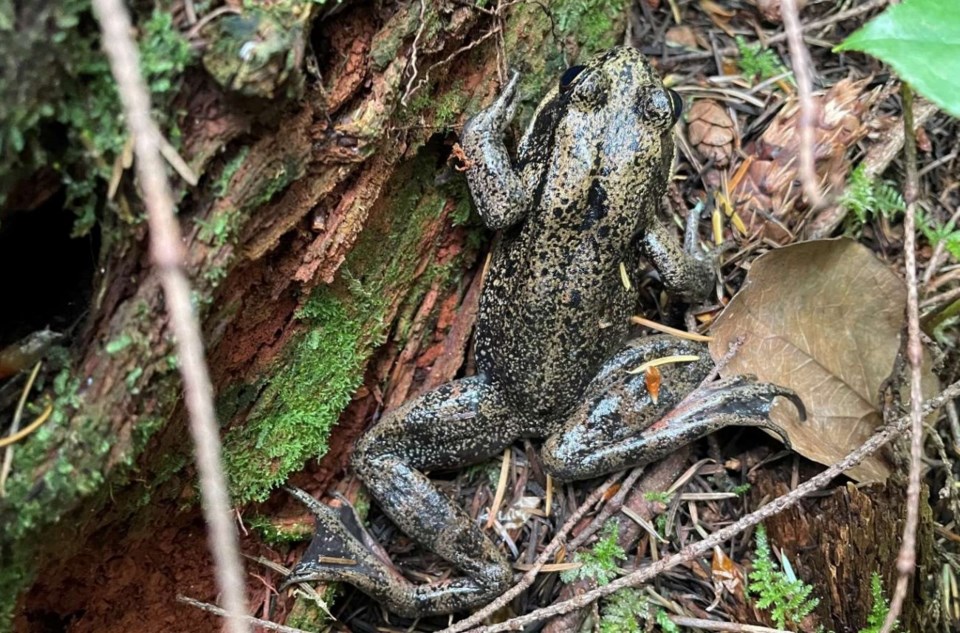A lone frog, sized to easily fit in the palm of an adult and on the provincial government’s endangered species “blue” list, (population vulnerable to changes in habitat) has raised more questions about B.C. Timber Sales' (BCTS) decision to log the Joe Smith Creek cutblock (TA0521, dubbed by some local residents as the Elphinstone Water Protection Forest) on the south Mt. Elphinstone slopes. On June 18, while hiking on a trail in that forest area, near Roberts Creek, Elphinstone Logging Focus (ELF) spokesperson Ross Muirhead photographed a northern red-legged frog (Rana aurora) after his movements startled it and caught his attention.
ELF's concerns
Red, blue and yellow species listings by the province identify ones (and related ecosystems) that can be considered for designation as "endangered" or "threatened." Under the Forest and Range Practices Act (FRPA), habitat for such species, but not others, require specific management protocols when planning for logging activity. This species of frog is known to be "terrestrial" in that they move between stream channels through the under storey, therefore they depend on intact forest areas for their survival. The red-legged frog does not afford specific habitat protection under the FRPA act, however BCTS voluntarily decided to create a "management protocol" when this species is found.
Since the rights to log the 13,815 cubic metres of timber on that 13-hectare parcel was awarded to Ocean View Logging on June 4, ELF alerted BCTS about the discovery the day after it happened. In that letter the forest protection group requested an amphibian survey be conducted by a registered biologist and the cutblock’s site plan be updated, per BCTS protocol. “In the meantime, no activities such as tree falling or road building should be undertaken,” ELF wrote in its letter to BCTS, which was shared with Coast Reporter.
On Aug. 12, ELF was advised BCTS was “taking the necessary steps in accordance with their certification requirements." Those details came in an email from Doug Wahl of B.C. Forest Practices Board, the province’s independent watchdog for sound forest practices. ELF had filed a complaint with that board regarding BCTS’s lack of a TA0521 amphibian survey. According to Wahl, FRPA does not have amphibian survey requirements, and therefore ELF’s “concern was outside the Board’s authority to investigate," but that BCTS did acknowledge that they have their own objectives for managing for these amphibians.
Neither logging nor road building has started on the site, as issuing of harvesting rights happened just before the dry summer season when forestry companies curtail their activities due to the risk of fires. Ocean View Logging was given into 2025 to complete its work.
Coast Reporter reached out to the Ministry of Forests to find out what the certification work regarding the amphibian population on TA0521 would entail and is awaiting a response. In Muirhead’s opinion, “A survey can be done in a day. Probably best completed during egg-laying season which I think is the spring or early summer to look for egg masses in the streams, which would be Slater Creek or Higgs Brook."
In addition to its concern about the frogs, ELF has advised BCTS that it is exploring legal advice on seeking an injunction to stop logging activities on TA0521 due to matters, “including lack of planning at the Landscape Unit level for old-growth recruitment, lack of endangered plant communities listings, presentation of expert reporting on hydrology, terrain stability issues, concerns of reckless approval of a timber sales when a MOTI [Ministry of Transportation and Infrastructure] stream-crossing review was never completed." The group set up an information blockade at the entrance to the cutblock this spring, looking to communicate the importance to the community of leaving the forests in this particular area intact.
About the frogs and their habitat
Northern red-legged frogs (Rana aurora) have reddish-brown and black-speckled bodies and range from seven to 10 centimetres in length. Federal government documentation from 2015 states that the name was derived from the translucent red undersides of the species’ hind legs. The frogs are found along the Pacific coast from southwestern B.C. to northwestern California, mainly in “structurally complex wetlands” throughout forested areas with elevations under 1,200 metres.
Rana aurora was first designated as being of special concern by the Committee on the Status of Endangered Wildlife in Canada in 1999 and is listed as such in the federal Species at Risk Act.
In B.C., it is ranked as being of “special concern, vulnerable to extirpation or extinction” by the Conservation Data Centre, in addition to being on the provincial blue list." It is protected from capture and killing, under the B.C. Wildlife Act.



